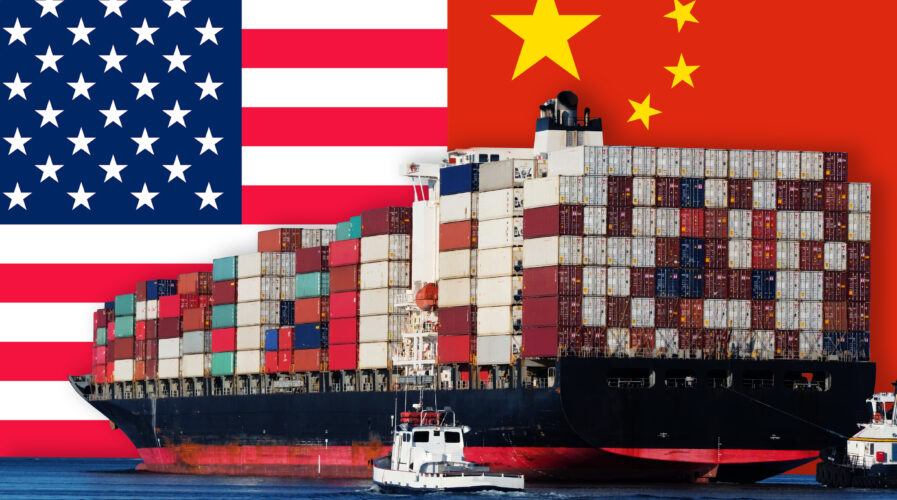
US chip ban on China may cost Lam Research a staggering US$2.5bn. (Source – Shutterstock)
As China cracks Western monopoly on CPU chips, US is trying to restrict SMIC’s advancement
- The US is continuing its rather passive-aggressive tone with China as the Biden administration is considering new targeted restrictions on shipments of chipmaking tools to China.
- The move is to hamstring advances by China’s largest chipmaker SMIC without slowing the flow of chips into the global economy.
- Meanwhile, China is seizing the opportunity to improve its self sufficiency in microprocessors, while breaking the monopoly held by US and British firms.
The global chip shortage has impeded the global economy over the last two years, but the real game-changer has been the steps taken by countries simultaneously to either be self-sufficient or restructure its supply chain. The US that was once making the world’s most leading-edge semiconductor chips, is now far behind a number of countries, especially from Asia. In its effort to catch up, the US, among all other measures it has taken, is now moving towards hindering the growth of the largest chipmaker in China, SMIC.
The Shanghai-based Semiconductor Manufacturing International Corp (SMIC) is considered the country’s national champion in producing chips used in various electronics products, from smartphones and computers to cars and mobile base stations. Since the world’s second-largest economy started bracing itself for a continuous heightened tech ware with the US, Semiconductor production has been a priority. It is apparently especially the latest five-year plan of China.
The US however wasn’t as quick as China to focus on semiconductors. Like most other countries, the US focus largely shifted towards semiconductor only since the pandemic. On the other hand, the mainland Chinese chip foundry has been able to quickly move up the technology ladder since it was established over two decades ago.
However, SMIC’s ability to close the technology gap with chip foundry giant Taiwan Semiconductor Manufacturing Co (TSMC) has been stymied by US trade sanctions, imposed because of its alleged ties to the Chinese military – a charge the firm denies. It is however about to get worse should hearsay on fresh US trade restrictions be true. According to an exclusive report by Reuters, the Biden administration is considering new targeted restrictions on shipments of chipmaking tools to China.
The move is mainly “seeking to hamstring advances by China’s largest chipmaker, SMIC, without slowing the flow of chips into the global economy,” five people familiar with the matter told Reuters. Basically, the US Commerce Department, which oversees export policy, is actively discussing the possibility of banning exports of chipmaking tools to Chinese factories that make advanced semiconductors at the 14 nanometer node and smaller. In short, it stymies China’s efforts at making more state-of-the-art chips, thus allowing the US to return to dominance within the semiconductor industry.
“In the meantime, the agency would allow those same tools to be sent to plants owned by the same firms but which make less advanced semiconductors, to safeguard the supply of commodity chips as the world recovers from a chip shortage,” Reuters reported. The Commerce Department has also stressed that the Biden administration regularly consults with allies and the industry about how best to tailor measures to deny China access to advanced technologies with both civilian and military uses.
Should the idea by the US move forward, it would be the first time the Commerce Department officially takes a factory-by-factory approach to export policy, although sources said unofficially it was now applying the approach to SMIC. As a result, SMIC, which has been focusing on mature technology nodes that are in high demand, will possibly face fresh hiccups to advance and catch up with industry players in Taiwan and alike.
To recall, SMIC said it began production of 14-nanometer chips in late 2019. The company was then added to a trade blacklist by the Trump administration over alleged military ties in 2020, but the measure banned only exports of a small subset of chipmaking equipment destined for the firm. That policy left decisions on exports of everything else up to the discretion of U.S. agencies, leading to long delays in approvals for licenses to ship to the company, as agencies bickered about what exports to greenlight.
Tit for tat: China cracking US dominance on CPU chips

As China cracks Western monopoly on CPU chips, US is trying to restrict SMIC’s advancement . (Photo by MANDEL NGAN / AFP)
China has been seeking ways to improve its self sufficiency in chips with most latest being microprocessors, the heart of every smart device. Since earlier this year, in a bid to minimize potential damage from US sanctions and to save on licensing fees, a growing number of Chinese chip design firms have adopted open-source RISC-V in their chip designs as an alternative to Intel’s proprietary X86 and Arm’s architecture.
For context, RISC-V is an open-source instruction set architecture for chip design that offers lower costs and greater access. Traditionally, processing cores—the best known of which are the central processing units (CPUs) found in computers, data centers, and phones—have been closed and proprietary. Proprietary instruction set architectures (ISAs) from Intel and Arm have made up nearly all CPUs deployed globally in recent years.
The open-source nature of RISC-V offers several advantages over proprietary ISAs. For one thing, it’s free. This can save companies millions of dollars in license fees, which is especially important for earlier-stage companies. For a second thing, it’s sanction-free: Being open-source, RISC-V is also not affected by export restrictions. This makes it appealing to companies, especially in China, that have been affected or fear being affected by those restrictions.
Hopes were high that RISC-V would enable China to crack the market for CPU designs, breaking the monopoly held by US and British firms, and in turn help the country achieve its strategic goal of self-sufficiency in chips. According to the South China Morning Post, a slew of RISC-V related businesses are emerging in China, with some backed by the country’s biggest tech players.
“Of the 20 “premier members” of RISC-V International, the non-profit organization which changed its base to Switzerland in 2020 to avoid potential US trade regulations, half are Chinese, including Huawei and Alibaba Cloud. T-Head, an affiliate of Post owner Alibaba Group Holding, is spending big on RISC-V IP, while HiSilicon, the chip design unit of sanction-hit Huawei Technologies Co, released its own RISC-V chip last year,” the article reads.
Although the architecture is unlikely to replace Intel and Arm in computers and smartphones any time soon, the future of RISC-V in China. Experts reckon that applications for RISC-V will come from smart home appliances, wearable gear, surveillance cameras, auto electronics, and industrial robots – which all have huge demand in China.
In a report by Deloitte titled ‘RISC-y business’, the author suggests even if trade policies change, Chinese companies would remain aware that, at any future point, the “ISA rug” could get pulled out from under them. “Going the RISC-V route could give them a way around that possibility, helping China meet its aggressive goals for reducing reliance on chip imports,” the report said.
READ MORE
- 3 Steps to Successfully Automate Copilot for Microsoft 365 Implementation
- Trustworthy AI – the Promise of Enterprise-Friendly Generative Machine Learning with Dell and NVIDIA
- Strategies for Democratizing GenAI
- The criticality of endpoint management in cybersecurity and operations
- Ethical AI: The renewed importance of safeguarding data and customer privacy in Generative AI applications


